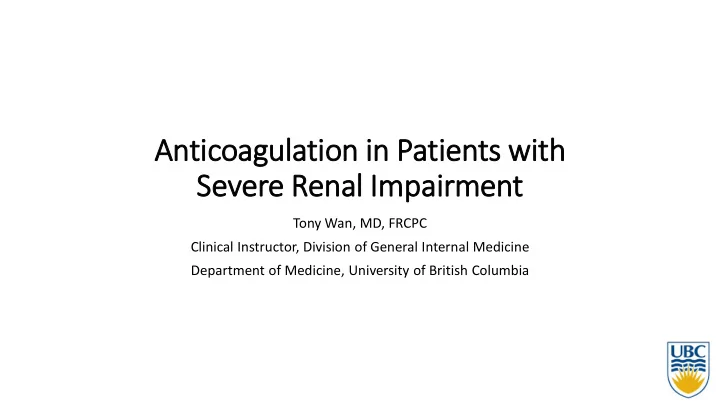

An Anticoagul ulation i n in Patients w with h Sev evere e Renal I Impair irmen ent Tony Wan, MD, FRCPC Clinical Instructor, Division of General Internal Medicine Department of Medicine, University of British Columbia
Objectives • Discuss the use of direct oral anticoagulant in patients with severe renal impairment • Discuss the use of low molecular weight heparin in patients with severe renal impairment
Disclosures Grants from Servier and Bayer for expanding the Thrombosis Clinic at St. Paul’s Hospital
Meet our patient Shannon 86 year old woman with multiple comorbidities including diabetic nephropathy with a CrCl of 21ml/min. She presents with acute pleuritic chest pain, shortness of breath, tachycardia and a normal CXR. BP 140/84. V/Q scan shows mismatch in a segmental distribution consistent with pulmonary embolism. How are you treating her acute pulmonary embolism?
Meet our patient Shannon 86 year old woman with multiple comorbidities including diabetic nephropathy with a CrCl of 21ml/min. She presents with acute pleuritic chest pain, shortness of breath, tachycardia and a normal CXR. BP 140/84. V/Q scan shows mismatch in a segmental distribution consistent with pulmonary embolism. How are you treating her acute pulmonary embolism? A) Enoxaparin SC with transition to warfarin B) Dalteparin SC with transition to warfarin C) Tinzaparin SC with transition to warfarin D) Unfractionated heparin IV infusion with transition to warfarin E) Rivaroxaban PO F) Apixaban PO G) Other
Direct Oral Anticoagulants (DOAC) Medscape
Renal Clearance Dabigatran Rivaroxaban Apixaban Edoxaban Renal Clearance (%) 80% 33% 25% 33-50% Half-life (hours) 12-17 5-9 9-14 9-11 Dialyzability Yes No No No Kassim N. Journal of Applied Hematology 2015
Apixaban for VTE Treatment and Prevention • Not recommended in patients with CrCl < 15 ml/min or in those undergoing dialysis • Use with caution in patients with CrCl 15 – 29 ml/min because limited clinic data indicated that plasma concentrations are increased Apixaban Monograph 2018
Apixaban for Atrial Fibrillation Renal Function Recommendation CrCl 25 – 30 mL/min According to the ABC criteria CrCl 15 – 24 mL/min No dosing recommendation can be made as clinic data is very limited CrCl < 15 mL/min Not recommended Dialysis Not recommended Apixaban Monograph 2018
Apixaban for Atrial Fibrillation • Dose reduction from 5mg BID to 2.5mg BID for patients with at least 2 of the following characteristics • Age ≥ 80 • Body weight ≤ 60 kg • Serum Creatinine ≥ 133 micromole/L (1.5 mg/dL) Apixaban Monograph 2018
Hohnloser et al. European Heart Journal 2012
Meta-analysis on Risk of Bleeding with Apixaban in Patients with Renal Impairment Pathak et al. Am J Cardio 2015
RENAL-AF AF with CHA2DS2- VASc ≥ 2 and ESRD on hemodialysis ≥ 3 months Randomization Apixaban 5mg BID with Warfarin (INR 2- 3) reduction for selected patients Time to major bleeding or clinically relevant non-major bleeding events with 15 months follow up NCT02942407
RENAL-AF AF with CHA2DS2- VASc ≥ 2 and ESRD on hemodialysis ≥ 3 months Estimated completion by 2020 Randomization Apixaban 5mg BID with Warfarin (INR 2- 3) reduction for selected patients Time to major bleeding or clinically relevant non-major bleeding events with 15 months follow up NCT02942407
Rivaroxaban Renal Dosing Not recommended in patients with CrCl < 15 ml/min Rivaroxaban Monograph 2018
FDA Clinical Pharmacology Biopharmaceutics Review 2011
XARENO Patients with non-valvular AF and eGFR 15 – 49 ml/min Treating physician to decide on rivaroxaban, warfarin or no anticoagulation (non interventional) Efficacy and safety outcomes with 12 month follow up NCT02663076
Low Molecular Weight Heparin (LMWH) Enoxaparin Dalteparin Tinzaparin Wood. NEJM 1997
LMWH Renal Dosing Hughes et al. Clin Kidney J 2014
Tinzaparin • Largest licensed LMWH and the clearance is less dependent on renal function • Available evidence for tinzaparin demonstrates no accumulation in patients with CrCl level down to 20 mL/min • Limited data available in patients with CrCl < 20 mL/min Tinzaparin Monograph 2017
TRIVET Patients with objectively confirmed venous thromboembolism CrCl > 60ml/min CrCl < 30ml/min Dialysis CrCl 30 – 60ml/min Tinzaparin 175IU/kg SC daily for 7 days Primary outcome = Anti- FXa level measured at day 3, 5 and 7 Secondary outcome = recurrent VTE and bleeding Lim et al. Journal of Thrombosis and Haemostasis 2016
TRIVET Lim et al. Journal of Thrombosis and Haemostasis 2016
Tinzaparin vs Dalteparin for Periprocedure Bridging in Hemodialysis Patients Rodger et al. AJKD 2012
Back to our patient Shannon 86 year old woman with multiple comorbidities including diabetic nephropathy with a CrCl of 21ml/min. She presents with acute pleuritic chest pain, shortness of breath, tachycardia and a normal CXR. BP 140/84. V/Q scan shows mismatch in a segmental distribution consistent with pulmonary embolism. How are you treating her acute pulmonary embolism? A) Enoxaparin SC with transition to warfarin B) Dalteparin SC with transition to warfarin C) Tinzaparin SC with transition to warfarin D) Unfractionated heparin IV infusion with transition to warfarin E) Rivaroxaban PO F) Apixaban PO G) Other
Take H Home M e Message? e?
Take H Home M e Message? e? Unfortunately w we cannot a abolish unfractionated h heparin At t lea east n not n t now…
Recommend
More recommend